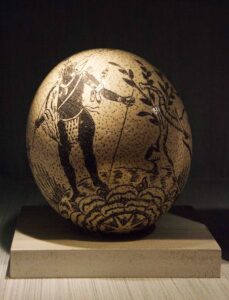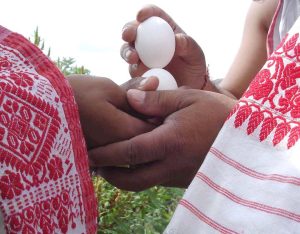Getting tired of your same-old Easter celebration? Why not try something new? Kids will crack up while playing these shell-breaking games, and you might even add some new color to your holiday.

[Wikimedia/Grahn
(CC BY-SA 3.0)]
Jarping Red Eggs
Red eggs are not particularly common in Western Christianity, but they are the norm in some Orthodox traditions. Most sources say the practice represents Christ’s blood, but more elaborate tales can also be found. According to one legend, Mary Magdalene and Mary the mother of Jesus put a basket full of eggs at the foot of the cross. Jesus’ blood, flowing from the gruesome crucifixion, turned the eggs red.
In another legend, Mary Magdalene was dining with the emperor of Rome. When she spoke of Jesus’ resurrection, he laughed and declared that a man rising from the dead was about as likely as the egg in her hand turning red. Of course, the egg turned red immediately.
The oldest notions around red eggs probably come from the Pagan tradition. Some neo-Pagans claim that ancient Druids would dye eggs red to symbolize menstrual blood and life force energy. The eggs would then be buried in newly-plowed fields as part of sacred, magic rituals designed to promote fertility and new life.
One way or another, red eggs have been around for a long time. Traditionally, onion skins were used as the dye. Nowadays, most people use red food coloring. Brown eggs will also help to deepen the color more than white eggs. Here’s a fairly simple recipe if you’re ready to expand your Easter egg color palette this year.
In a large saucepan, add 1 cup of water, 1 tablespoon of vinegar, and 3 teaspoons of red food coloring per egg and bring to a boil. Remove from heat and add your hard-boiled eggs. Allow the eggs to remain in the dye until they are the desired color — usually about 30-45 minutes. Remove the eggs from the dye with a slotted spoon and place them on paper towels to dry. When dry, the eggs can be polished with vegetable oil to make them shiny.

(public domain)]
Tsougrisma is a fun, informal game, so you can’t really play it incorrectly. Some people tap the small ends of the eggs together; some people tap the thick ends together; and some people alternate for each round. Some players also incorporate the Easter theme by having egg-tapper #1 say “Kristos Anesti” (Christ is risen) and egg-tapper #2 reply “Haristos Anesti” (He is risen indeed) before tapping.
The written rules make the game seem much more difficult than it really is, so it’s probably best to watch a short You Tube video. This video of a family playing in the backyard, this video of two boys playing, and the last 30 seconds of this video will help you develop your own set of rules for playing the game.
Cascarónes
Another way to add pizzazz to your Easter tradition is to make cascarónes {kahs-kah-ROH-nays}, the confetti-filled eggs popular in Mexico. To make them, simply punch a small hole in one end of the egg. Dump out the egg white/yolk and rinse the empty shell with warm water. Let dry. Then, refill the egg with confetti, and cover the hole by gluing on a tissue paper square. Now, crack the egg over someone’s head for good luck. Cascarónes are a relatively new tradition — probably invented sometime in the 19th century — but they’re still super fun, especially for kids.